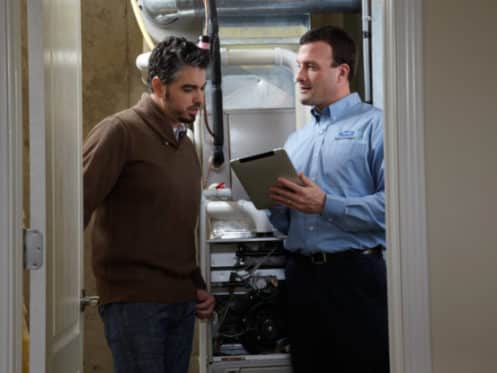For many decades, gas furnaces have been the most popular way to heat American homes. This has begun to change, as heat pumps outsold furnaces for the first time in 2023. Which is better for your home will depend on your heating needs and the long- and short-term costs. Let’s explore electric and gas heat in terms of those costs and their performance.
Fuel-Fired Furnaces
Fuel-fired furnaces, commonly called gas furnaces, generate heating directly by burning fuel. It allows them to heat the air quickly and to a high temperature. That temperature is usually between 140 and 170 degrees Fahrenheit initially. It drops by about 50 degrees by the time it reaches you.
Natural Gas
Furnaces that burn natural gas are preferable since the fuel is relatively cheap. There are some things to consider, though. You can’t store natural gas in a tank. Your home must have access to a natural gas line. If it doesn’t, you’ll have to choose an alternate fuel. If you’ve gained natural gas access since your last furnace, converting to it will require additional installation costs.
Another potential consideration is that natural gas is a finite resource. It’s been abundant for many decades in the United States, but we’re in the last century of our supply. The U.S. is unlikely to run out while you own this furnace or the next. That said, experts expect the federal government to incentivize other forms of heat, such as heat pumps. The U.S. Energy Information Administration (EIA) also expects natural gas prices to continue rising.
Alternatives to Natural Gas
The most popular alternatives to natural gas are propane and heating oil. These are fuels that you can store on your property in a tank. Depending on your region, you may have access to one, the other, or both. If you can choose, the better option depends on prices in your area and which other appliances you have that burn fuel. Propane and heating oil deliver more British thermal units (BTUs) per gallon than natural gas. That means they’re more efficient, but natural gas is still cheaper.
Mid-Efficiency Furnaces
The industry rates furnace efficiency using the annual fuel utilization efficiency (AFUE) metric. A furnace with an 80 AFUE rating converts 80% of the fuel it burns into heat. The other 20% escapes through the exhaust. All furnaces sold in the U.S. must have a minimum rating of 80 AFUE. Standard or mid-efficiency furnaces range as high as 83 AFUE.
High-Efficiency Furnaces
A high-efficiency furnace has an AFUE rating of 90 to 98.5. One type of high-efficiency furnace is the condensing furnace. These units have a second heat exchanger and can reclaim some gases that would otherwise escape. There are also two-stage and variable-stage furnaces. Traditional furnaces are single-stage systems, which means that they run at a consistent speed when on. Two- or dual-stage furnaces can conserve fuel by switching between low and high settings as needed. Variable- or multi-speed furnaces can run at between 40% and 100% capacity in 5% increments.
Electric Heat
While all combustion furnaces are fundamentally the same, this isn’t the case with electric heat. There are two core approaches: generating heat directly or transferring heat energy.
Electric Furnaces
Electric furnaces are similar to fuel-fired furnaces in that they generate heat directly. Rather than use combustion, they use an electric heat exchanger. Electric furnaces are more thermally efficient. These systems have an AFUE of 95 to 100. The problem is the price of electricity often makes them too expensive to run. They’ve become less common in recent years especially as the heat pump has become much more sophisticated.
Heat Pumps
Heat pumps don’t generate heat. They use a refrigeration cycle to transfer heat energy from one medium to another. The industry uses the heating seasonal performance factor (HSPF) to measure heat pump heating efficiency. The higher the rating, the more efficient the heat pump. Note that you cannot compare HSPF to AFUE.
Air-source heat pumps, which are the most prevalent, transfer heat energy between the ambient and indoor air. Ground-source heat pumps transfer it between the earth and indoor air. This process is highly efficient and even more affordable than running a furnace that burns natural gas. The issue with air-source heat pumps is that they can become inefficient at colder temperatures. The solution is hybrid heating.
Dual-Fuel Heating
A dual-fuel or hybrid HVAC system combines an air-source heat pump with a fuel-fired furnace. The heat pump delivers efficient heating most of the time. The furnace takes over when the heat pump would be inefficient, such as below 35 degrees. The potential downside is a higher initial expense. It will cost more to replace an AC and furnace with a heat pump and furnace. The upside is that you’ll save over the long term due to lower operating and equipment costs.
Ductless Mini-Splits
A mini-split is either an air conditioner or a heat pump. The heat pump models often have electric heating strips for cold weather. This isn’t a cost-effective approach, but the idea is that you only need them on certain nights and for short periods. A mini-split also offers better energy efficiency in general. It has inherent HVAC zoning, and there’s no air leakage since there are no ducts.
Up-Front and Operating Costs
Electric furnaces are initially cheaper than fuel-fired furnaces but cost more over the life of the equipment. Furnaces cost less than heat pumps, but many homeowners will compare a furnace and AC to a furnace and heat pump. In that case, the difference is not as sharp. A standalone furnace will be less expensive long-term than a standalone heat pump. That said, a dual-fuel setup is the most affordable option over the life of the equipment. Another consideration is the rebates and tax rebates available for heat pumps and high-efficiency furnaces. These incentives can significantly reduce your initial costs.
Performance
Furnaces can heat a home more quickly. This is a factor when first turning these systems on but becomes less of an issue as you run the systems. Another consideration is that heat pumps provide warm air at about 90 degrees. That’s hot enough to heat your home but cooler than your body temperature. It’s why some people prefer the feel of gas heat. It can also be a noticeable difference when hybrid heating switches between the pump and furnace.
Neither gas nor electric heating should smell. When it does, it’s generally burning dust or, in the case of the heat pump, microbial growth on the evaporator coil. If you get a rotten egg smell from a gas furnace, you may have a gas leak. Another concern with gas heating you don’t have with electric heating is carbon monoxide (CO) poisoning. You’ll need CO detectors in the home, and your fuel-fired furnace will require additional maintenance each season.
Local HVAC Experts in the Triangle Since 1998
72 Degrees Heating & Air Conditioning has served homeowners throughout Apex, NC and the surrounding areas for over 25 years. Our NATE-certified technicians install and service gas furnaces, heat pumps, air conditioners, ductless mini-splits, and dual-fuel systems. We also specialize in HVAC filters, smart thermostats, air purifiers, dehumidifiers, and humidifiers. Our team performs gas heating conversion, crawl space encapsulation, and ductwork installation and repair.
To schedule an appointment for any of our services, call 72 Degrees Heating & Air Conditioning today!


